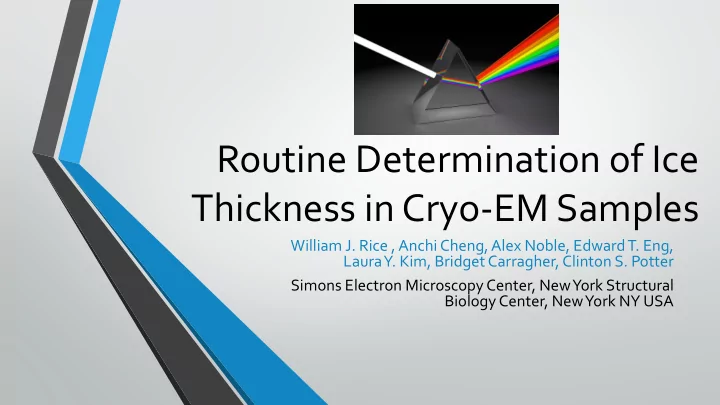

Routine Determination of Ice Thickness in Cryo-EM Samples William J. Rice , Anchi Cheng, Alex Noble, Edward T. Eng, Laura Y. Kim, Bridget Carragher, Clinton S. Potter Simons Electron Microscopy Center, New York Structural Biology Center, New York NY USA
Energy Filter Separates Images into Energy Loss Spectra Thickness can be determined by integrating entire spectrum and zero loss peak: 𝑒 = Λ ln 𝐽 𝐽 𝑨𝑚 Λ: mean free path for inelastic scattering through ice Image Source: Wikipedia
Take images with and without slit to get I zlp and I 15 eV slit No Slit
Literature values for Λ vary widely, mostly measured at low voltage
Collect Tomograms, measure thickness and plot ) against ln ) *+ to get Λ
Collect Tomograms, measure thickness and plot ) against ln ) *+ to get Λ
Protocol • Take exposure image • Take short image without energy filter, same area and same beam conditions • Take short image with energy filter, same area and same beam conditions
Test Sample: Rabbit Muscle Aldolase Sample collected on Titan Krios with K2 GIF, 100 μm objective aperture, pixel size 0.855 Å 130,000 particles in final reconstruction
Most images were 15-20 nm thick
Thickness 17 nm: Thon Ring Extent 2.73 Å Defocus=-0.94 μm
Thickness 125 nm: Thon Ring Extent 6.77 Å . Defocus: -1.77 μm
Thon Ring Extent vs. Thickness
Integration into Leginon
Conclusions • Ice thickness is easy to measure with an energy filter • Thickness measurements can be integrated into standard single particle workflow • Thickness measurements could be used as a guide during initial screening Acknowledgements Bridget Carragher, Clint Potter SEMC-OPS and NRAMM teams at NYSBC Various users of SEMC for test data
Recommend
More recommend